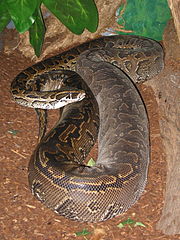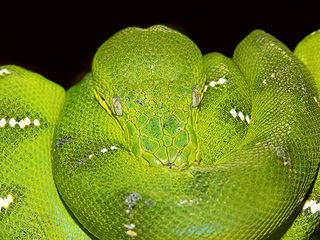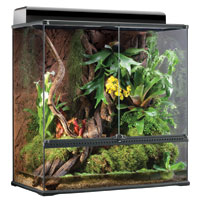As a child pouring over Clifford Pope’s classic book The Giant Snakes, I came across an account of an African Rock Python (Python sebae) that had consumed a 130 pound impala antelope. I pictured the scene, and determined to learn more about this largest of all African snakes. As a teenager, I went to work for a well-known NYC animal importer. In the course of unpacking hundreds of African Rock Pythons, all straight from the wild, I came to respect their ferocity – Reticulated Pythons, huge Florida Green Watersnakes, Anacondas and other notable “nasties” paled in comparison! Working at the Bronx Zoo’s herpetology department, I read reams of Copeia, Herpetological Review and Herpetologica back issues, always scouting for unusual feeding records. I was not disappointed…certain populations of African Rock pythons seem especially capable, even by large constrictor standards, of taking huge prey items…humans included (please also see this article on human predation by Reticulated Pythons). Incidentally, the impala mentioned above may be the largest snake meal ever documented. It was recorded in 1955 in South Africa – the 60 pound deer regurgitated by a Green Anaconda I tagged in Venezuela pales in comparison! Read More »
Category Archives: Non-venomous Snakes
Feed SubscriptionMilksnake Care – Keeping the Sinaloan Milksnake and Related Species
The various Milksnakes are among the world’s most beautifully-colored reptiles. Most are quite hardy, easy to handle and breed, and can be kept in modestly-sized terrariums. Milksnakes are grouped with Kingsnakes in the genus Lampropeltis, which contains 16 species. Sometimes referred to as “Tri-Colored Kingsnakes”, the most popular types are considered to be subspecies of L. triangulum. Among the 26 subspecies of L. triangulum we find the gorgeous and highly-desirable Sinaloan, Pueblan, Nelson’s, Black, and Honduran Milksnakes, along with others that are a bit more difficult to keep but well-worth the consideration of experienced keepers.
The following general information can be applied to Milksnake care of both popular species and subspecies. However, details vary, especially as regards those native to higher elevations or with specific food preferences. Please post below for detailed information on the care of individual species. Read More »
Rock Python Kills Full-Grown Husky in Florida
At least 45 species of non-native reptiles and amphibians have established breeding populations in Florida. The most notorious of these, the Burmese Python, Python bivittatus, has been much in the news in recent years. Recently, however, another of the state’s introduced giant constrictors grabbed the headlines.
On Sept. 10, 2013, a Northern African Rock Python, P. sebae, killed a 60 pound husky in a suburban yard near the Everglades. While much has been made of the threats posed by large constrictors, what interested me most about this incident was the fact that the snake involved was quite small by Rock Python standards. Despite being only 10 foot long and 38 pounds in weight, the snake was able to overcome and kill a 60 pound dog.
Based on my experiences with large constrictors in the Bronx Zoo and the wild, I would guess that the attack was defensive in nature. The only 60 pound snake meal I’ve witnessed (a White-tailed Deer) involved a 17 foot long, 215 pound Green Anaconda…and its huge body appeared stretched to its limit. Read More »
Emerald Tree Boas in the Wild – Applying Natural History to Pet Care
The Emerald Tree Boa is extremely popular in zoos and private collections, but its life in the wild remains relatively unstudied. What little we have learned has come mainly from chance observations rather than long-term studies. Cryptic coloration, nocturnal ways and a life spent high in tropical forest canopies or dense brush has served to shroud their habits in mystery. But each bit of knowledge has helped us to better keep and breed this magnificent snake. For example, studies of the Emerald Tree Boa’s natural habitat have revealed the importance of providing captives with humid but airy enclosures, and temperatures that are somewhat lower than one might expect.
Range
Emerald Tree Boas are native to two distinct but adjacent areas of northern South America – the Guyana or Northern Shield region and the Amazon Basin. Individuals from each area differ somewhat in appearance, and some have suggested that 2 subspecies should be named. Corallus batesii has been proposed for the Amazon Basin population by those who believe that 2 distinct species are present.
Description: Differences between the Two Major Populations
Snakes from the Guyana Shield region, which encompasses parts of Surinam, Guyana, French Guiana and Venezuela, are light green in color (often described as “lime green”), and have noticeably larger head scales than do those further south. Read More »
Boa Care – Emerald Tree Boa Terrariums, Husbandry and Diet
Boa Care: Emerald Tree Boa Terrariums, Husbandry and Diet
The breathtakingly-beautiful Emerald Tree Boa (Corallus caninus) has long topped snake enthusiasts’ wish lists. Demanding husbandry requirements and a somewhat surly disposition adds to its mystique. I’ve had some success in breeding this species in zoos, and private keepers have made important strides in recent years, but misconceptions and information gaps persist. Today we’ll discuss Emerald Tree Boa care; please look for my article on its interesting natural history in the near future.
The Terrarium
Cage height is an important factor. Observations of animals kept in small enclosures have led to this snake being labeled as “sedentary”, but those in large, complex habitats move about quite a bit.
An enclosure measuring measuring 4 feet by 3 feet x 4 feet in height is ideal for a large adult. Males and smaller females may get by in 75-100 gallon aquariums turned on their narrow ends, but custom-made cages are a much better option.
Cages that open from the front are preferable, as Emerald Tree Boas are stressed by approaches from above (perhaps because birds of prey are their major predators). In front-opening terrariums, they will often remain on their perches while the cage is serviced (sparing snake and snake-keeper stress and injury!). A variety of commercial cages are suitable for youngsters.
Cage Furniture
Well-anchored branches of varying thicknesses, both forked and straight, should be installed. Emerald Tree Boas often coil at the spot where 2 forks of a branch diverge, so be sure to include several.
Pots of tall, sturdy live plants (philodendron, small ficus trees, snake plants) should be placed about the cage to provide security and aid in humidity control. Artificial plants hung from branches and the cage top can also be used as cover (I favor this model).
Substrate
Newspapers and washable terrarium liners work well as substrates in aquariums. In larger enclosures, cypress mulch or forest floor bedding will allow for easy spot-cleaning and help to raise the humidity level.
Light
UVB exposure is not required, but UVA bulbs may encourage natural behavior, and will bring out the true beauty of their coloration. A day/night schedule of 12:12 hours should be maintained. Red/black reptile “night bulbs” will allow you to observe nocturnal behavior.
Heat
This species is closely associated with rainforests in most keepers’ minds, and this sometimes leads to a misunderstanding of their needs. Arboreal snakes experience greater temperature and humidity fluctuations than do terrestrial snakes living in the same habitats. Emerald Tree Boas prefer cooler temperatures than one might imagine.
Incandescent bulbs should be used to maintain a temperature of 75-77 F, and a basking spot of 85 F. At night, a dip to 72 F is beneficial A ceramic heater or red/black reptile “night bulb” can be used to provide heat after dark.
Large enclosures are necessary if a thermal gradient (areas of different temperatures) is to be established. Thermal gradients, critical to good health, allow snakes to regulate their body temperature by moving from hot to cooler areas.
Humidity
These moist-forest denizens (please see photo of typical habitat) require humidity levels that fluctuate between 60 and 90%. Humidity can be increased via manual spraying, moistening the substrate and commercial reptile misters. Humidity should be highest during the day, and decline with the temperature at night.
Wet conditions and stagnant air will lead to skin diseases. Ample air flow, often overlooked in the past, is now recognized as critical to good health. The terrarium’s top should not be covered with glass to increase humidity; a small fan may be employed to circulate air if necessary.
Emerald Tree Boas are best offered food via tongs. Slowly moving the food in front of the snake, or lightly touching the jaws or body, often induces a strike. Juveniles feed primarily upon lizards and frogs, and many refuse mice. Scenting small mice (fuzzies or hoppers) with a lizard or shed lizard skin may be helpful.
Chicks, quail, gerbils or (for newborns) house geckos may spur picky feeders to take a meal. In time, these can be used to scent mice.
A Note on Meal Size and Frequency
Meal size is an important factor in maintaining good health. Always use smaller food items than you might for similarly-sized snakes of other species. Half-grown rats suffice for even the largest individuals. Regurgitation, a very common ailment, seems linked to overly-large meals and excess food intake.
Emerald Tree Boas have extremely efficient, and somewhat “slow”, digestive systems, and do not usually defecate after each meal. They need comparatively little food, and typically regurgitate if overfed. Snakes confined in small cages that do not allow for sufficient movement often have trouble passing fecal material. Forcing the animal to swim may help.
Newborns should be fed every 10 days; juveniles at 2 week intervals. Adults require, on average, 2 mice or a small rat every 3 weeks.
Water
A bowl should be provided, but most individuals will only take water that is sprayed onto their bodies and the foliage. Some will drink from a watering can tilted in front of the mouth. Punctured plastic containers placed on the cage’s top and small waterfalls may also be utilized.
It can be difficult to provide enough water via misting. Dehydration, indicated by skin ridges and sunken eyes, is not uncommon. At the Bronx Zoo, I’ve injected water into dead rats to accommodate Amethystine Pythons and other reluctant drinkers. Please post below for details.
Handling
Although individuals vary, Emerald Tree Boas rarely accept handling and will bite if forcibly removed from their perches. Their teeth, some of which may reach 2 inches in length, can inflict serious injuries, especially if an eye or nerve is struck. In common with many arboreal snakes, they have quite a long strike range. Emerald Tree Boas are best considered as animals to observe and study rather than handle.
Detachable perches simplify handling, as some individuals will remain immobile if perch and snake are relocated together. Still, a shield and/or a snake hook should be kept between yourself and the animal. Others can be induced to leave their perches and climb onto a hook, but experience is needed. Constructing the cage in a way that allows for cleaning without moving the snake will limit stress and strikes.
 That Reptile Blog – Reptile, Amphibian and Exotic Pet Care and Information
That Reptile Blog – Reptile, Amphibian and Exotic Pet Care and Information






